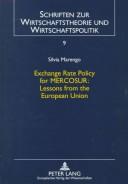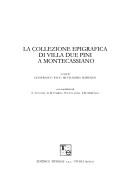| Listing 1 - 8 of 8 |
Sort by
|

ISBN: 3631327919 3631751370 Year: 2018 Publisher: Frankfurt a.M. PH02
Abstract | Keywords | Export | Availability | Bookmark
 Loading...
Loading...Choose an application
- Reference Manager
- EndNote
- RefWorks (Direct export to RefWorks)
In January 1995, four Latin American countries, Argentina, Brazil, Uruguay and Paraguay joined their destinies within a common and ambitious enterprise called MERCOSUR. MERCOSUR, the Common Market of the South, represents an important economic integration area that generates a GDP of $US 600 billion, providing a market of 200 million people spread over an area of 12 million square km. Initially, MERCOSUR performance has been more than successful, as intra-MERCOSUR trade has increased significantly. However, the elimination of intra-MERCOSUR tariffs will not be efficient if at the same time the sharp variability of nominal exchange rates artificially affects the relative prices of different products. The question as to the choice of the optimal exchange rate system to be adopted among MERCOSUR countries becomes critical if MERCOSUR states attempt to go further along the path of increasing their trade flows of goods and services. The study contributes to filling this gap by providing some alternative answers to this issue. The analysis has been based on three pillars: a theoretical review of exchange rate systems; a review of the European experience; and an analysis of the Latin American experience.
EEC / European Union - EU -Europese Unie - Union Européenne - UE --- LAM / Latin America - Latijns Amerika - Amérique Latine --- 333.825 --- 334.151.27 --- Deviezenpolitiek. Interventies. --- Europees monetair stelsel. --- Foreign exchange rates --- Exchange rates --- Fixed exchange rates --- Flexible exchange rates --- Floating exchange rates --- Fluctuating exchange rates --- Foreign exchange --- Rates of exchange --- Deviezenpolitiek. Interventies --- Europees monetair stelsel --- Rates --- MERCOSUR (Organization) --- Mercado Común del Sur --- Mercosul (Organization) --- Southern Cone Common Market --- Common Market of the South --- Mercado Común del Cono Sur --- Unión de Naciones Suramericanas --- South America --- Economic integration. --- Political science & theory --- Monetary economics --- International economics --- European --- Exchange --- from --- Lessons --- Marengo --- MERCOSUR --- Policy --- Rate --- Union
Book
Year: 1991 Publisher: Roma: Istituto italiano per la storia antica,
Abstract | Keywords | Export | Availability | Bookmark
 Loading...
Loading...Choose an application
- Reference Manager
- EndNote
- RefWorks (Direct export to RefWorks)
Book
Year: 1991 Volume: 49 Publisher: Roma : [Istituto italiano per la storia antica],
Abstract | Keywords | Export | Availability | Bookmark
 Loading...
Loading...Choose an application
- Reference Manager
- EndNote
- RefWorks (Direct export to RefWorks)
Inscriptions, Greek --- Inscriptions grecques --- Indexes --- Index
Book
ISBN: 9788860562838 886056283X Year: 2012 Publisher: Macerata : eum edizioni,
Abstract | Keywords | Export | Availability | Bookmark
 Loading...
Loading...Choose an application
- Reference Manager
- EndNote
- RefWorks (Direct export to RefWorks)
Inscriptions, Latin --- Graffiti --- Inscriptions, Greek --- Inscriptions latines --- Inscriptions grecques --- Objets usuels --- Ex-voto romains --- Temples romains --- Antiquités romaines --- Lieux sacrés --- Rome --- Antiquités romaines --- Lieux sacrés

ISBN: 8887994080 9788887994087 Year: 2005 Publisher: Tivoli : Tipigraf,
Abstract | Keywords | Export | Availability | Bookmark
 Loading...
Loading...Choose an application
- Reference Manager
- EndNote
- RefWorks (Direct export to RefWorks)
Inscriptions --- Epigraphs (Inscriptions) --- Epigraphy --- Inscription --- Paleography --- Epigraphists --- Montecassino (Monastery). --- Museo dell'abbazia di Montecassino --- Macerata (Italy : Province) --- Macerate, Italy (Province) --- Antiquities --- Exhibitions --- Épigraphie --- Montecassiano (Italie) --- Italie --- Antiquités
Book
ISBN: 9788888617152 Year: 2008 Publisher: Tivoli (Roma) : Tored,
Abstract | Keywords | Export | Availability | Bookmark
 Loading...
Loading...Choose an application
- Reference Manager
- EndNote
- RefWorks (Direct export to RefWorks)
Book
ISBN: 9788869240775 Year: 2015 Publisher: Macerata Edizioni Simpli
Abstract | Keywords | Export | Availability | Bookmark
 Loading...
Loading...Choose an application
- Reference Manager
- EndNote
- RefWorks (Direct export to RefWorks)
Book

ISBN: 9782728312405 2728312400 2728312419 9782728312412 Year: 2016 Volume: 527 Publisher: Rome : Publications de l’École française de Rome,
Abstract | Keywords | Export | Availability | Bookmark
 Loading...
Loading...Choose an application
- Reference Manager
- EndNote
- RefWorks (Direct export to RefWorks)
La principale distinction relative au droit des personnes est que tous les hommes sont soit libres soit esclaves (Institutes, I, 9). Gaius souligne ainsi la place fondamentale de l’esclavage dans la Rome impériale. La barrière de la liberté était si structurante et le recours au travail servile pratiqué à une telle échelle, que la société romaine mérite assurément le qualificatif d’esclavagiste. Certes, la condition servile était inférieure, mais la concevoir en terme de barrière ou de strate horizontale, séparant les esclaves et les libres, se révèle insuffisant. Dans une population servile à la hiérarchie très marquée, la condition personnelle des esclaves dépendait beaucoup des relations verticales, qui unissaient chacun d’entre eux à leur maître. Tel est le sujet de ce livre collectif. L’examen prioritaire de la documentation épigraphique vise à en restituer la complexité. Il fait place à des serviteurs, à des domesticités et à des maîtres d’une grande diversité, dans différentes régions de l’Empire. Les grandes étapes de la vie des hommes et des femmes réduits en esclavage (l’enfance, la mort, en passant parfois par l’affranchissement) sont prises en compte. C’est aussi dans ses multiples dimensions, du droit aux affects, que la relation entre esclaves et maîtres se trouve mise en lumière.
Slaves --- Slavery --- Inscriptions, Latin --- Esclaves --- Esclavage --- History --- Law and legislation --- Sources. --- Droit romain. --- Slavery (Roman law) --- Social classes --- Social conditions --- Inscriptions, Latin. --- Slavery. --- Social classes. --- Social conditions. --- Inschrift --- Sklaverei --- Rome --- Rome (Empire) --- Römisches Reich --- Class distinction --- Classes, Social --- Rank --- Caste --- Estates (Social orders) --- Social status --- Class consciousness --- Classism --- Social stratification --- Roman law --- Abolition of slavery --- Antislavery --- Enslavement --- Mui tsai --- Ownership of slaves --- Servitude --- Slave keeping --- Slave system --- Slaveholding --- Thralldom --- Crimes against humanity --- Serfdom --- Slaveholders --- Latin inscriptions --- Latin language --- Latin philology --- Enslaved persons --- Persons --- Sklave --- Unfreiheit --- Epigraph --- Inschriften --- Epigraf --- Schriftdenkmal --- Epigraphik --- Condition of slaves --- Imperium Romanum --- Reich Rom --- Italien --- Antike --- Römerzeit --- Römer --- v753-500 --- Rim --- Roman Empire --- Roman Republic --- Romi (Empire) --- Italy --- Roman Republic (510-30 B.C.) --- Byzantine Empire --- Rome (Italy) --- Geschichte 753 v. Chr.-500 --- Slavery - Rome - History - Sources - Congresses --- Inscriptions, Latin - Congresses --- Slaves - Rome - Social conditions - Congresses --- Slavery (Roman law) - Congresses --- Social classes - Rome - Congresses --- épigraphie --- esclaves --- droit --- religion
| Listing 1 - 8 of 8 |
Sort by
|

 Search
Search Feedback
Feedback About UniCat
About UniCat  Help
Help News
News